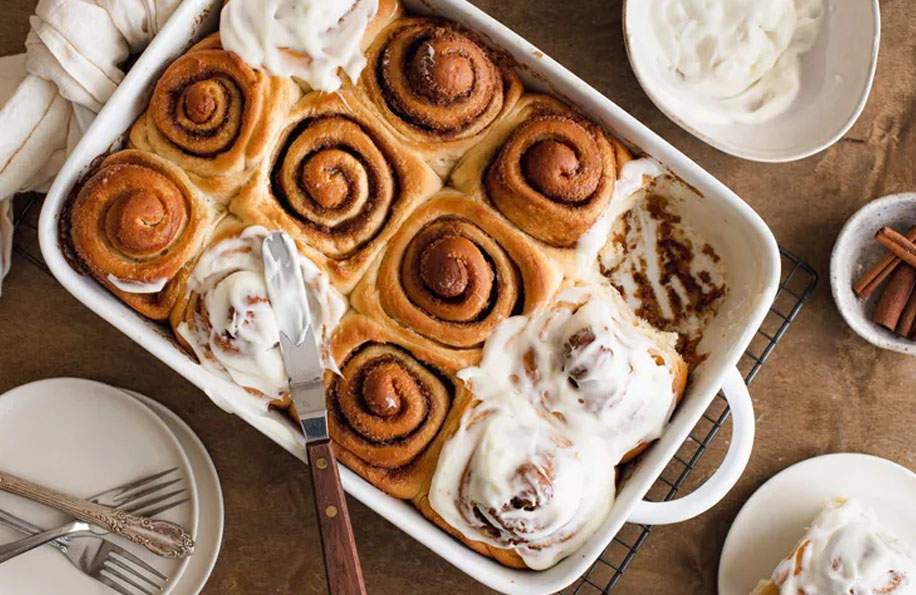There’s nothing quite like a soft, fluffy cinnamon roll. Especially if it’s a sourdough cinnamon roll! The slight sour edge of the starter is the perfect complement to the sugary cinnamon filling and cream cheese frosting.
RELATED: Chocolate Cranberry Zucchini Muffins | Learn Recipe 2023
TABLE OF CONTENTS
●Igredients
●Instructions
●Serve
Ingredients
For the dough
●1 1/4 cup (282g) whole milk
●1/3 cup (75g) sugar
●2 large eggs
●1/2 cup (113g) sourdough discard
●2 1/4 teaspoons (7g) active dry yeast
●4 1/2 cups (540g) all-purpose flour
●1/4 cup (30g) cornstarch
●1 teaspoon (6g) kosher salt
●8 tablespoons (113g) unsalted butter, softened
For the filling
●1 cup (170g) brown sugar
●1/2 cup (113g) granulated sugar
●1 tablespoon (10g) ground cinnamon
●1/2 teaspoon (4g) kosher salt
●4 tablespoons (56g) unsalted butter, softened
For the frosting
●3.5 ounces/100g (7 tablespoons) cream cheese, softened
●1/2 cup (65g) powdered sugar
●1 tablespoon (14g) unsalted butter, softened
●2 tablespoons (28g) whole milk
Method
1.Warm the milk:
In a small saucepan over medium low heat, warm the milk until it reaches 170°F or tiny bubbles start to appear on the edges and a skin forms on the surface. Transfer the milk to a large liquid measuring cup and let it cool slightly.
2.Add the sugar, eggs, and discard to the milk, then the yeast:
Add the sugar, eggs, and sourdough discard to the milk in the measuring cup. Lightly whisk to mix the ingredients together. Make sure the mixture is cool to the touch (cooler than 120°F; any warmer and it may harm your yeast). Stir the yeast into the milk mixture and set aside for 10 minutes. The mixture should look bubbly and smell sweet and yeasty.
3.Combine the dry ingredients:
In a large bowl, whisk together the flour, cornstarch, and salt. Create a well in the center of your flour mixture and pour the milk mixture into the middle. Stir everything together using your hands or a spatula until you end up with a sticky, lumpy dough (don’t worry, the lumps are totally normal).
4.Knead the butter into the dough:
Once your dough begins to form a cohesive mass, knead the 8 tablespoons of softened butter into the dough 1 tablespoon at a time. The dough will look oily after each addition, but will start to look smoother and feel less sticky after the butter is properly incorporated. Wait to add more butter until each portion is fully incorporated, or when your dough no longer feels greasy. Your dough will be soft and supple after all the butter is incorporated, but may still feel sticky.
5.Rest the dough:
Round the dough into a tight ball and place it inside a lightly oiled large bowl. Cover the bowl with plastic wrap and let it rest for 10 minutes. This will allow the flour to fully hydrate and make the dough less sticky and easier to work with.
6.Knead the dough again:
Turn the dough out onto a clean work surface. Set the bowl aside for later use.
Knead the dough until it looks completely smooth, about 5 minutes. Round the dough into a tight ball and return it to the bowl. Cover the dough with plastic wrap.
7.Proof the dough:
Let the dough rise in a warm place until it’s doubled in size, 45 minutes to 1 hour. Timing might vary depending on the activity of your yeast and the warmth of your kitchen.
8.Make the cinnamon sugar filling:
In a medium bowl, use a whisk to combine the brown sugar, granulated sugar, cinnamon, and salt. Set aside until your dough is ready to be shaped.
9.Shape the rolls:
Turn your dough out on a lightly floured work surface. Using a rolling pin, flatten the dough out into a 24×10-inch rectangle, about 1/4 inch thick.
10.Spread butter and filling on the dough:
With an offset spatula, spread an even layer of 4 tablespoons of softened butter on top of your dough. Sprinkle the cinnamon sugar filling on top of your dough, leaving a 1-inch margin all around the border. Pat the filling on the dough to help it adhere.
11.Roll up the dough:
Working with the longer side of your dough, roll it into a tight cylinder. Pinch the edge of your dough to seal the filling in.
12.Roll up the dough:
Working with the longer side of your dough, roll it into a tight cylinder. Pinch the edge of your dough to seal the filling in.
13.Preheat your oven:
Preheat your oven to 375°F.
14.Let the rolls rise:
Cover your pan with plastic wrap and allow your rolls to rise untouched for 30 to 45 minutes, or until your rolls look puffy and are beginning to touch each other.
15.Bake the rolls:
Bake the rolls for 40 to 45 minutes, until they are golden brown. When probed with an instant-read thermometer, the thermometer should read 195°F.
16.Make the frosting:
While your rolls are baking, beat the cream cheese and powdered sugar together with a hand mixer. Once the mixture is smooth and aerated, add the butter and milk and continue beating until smooth, with no lumps remaining. Set aside until ready to use.
17.Frost and Serve:
When you take your rolls out of the oven, spread an even layer of frosting on top.
These rolls are best enjoyed the day they are baked, but will keep well in an airtight container at room temperature for up to 3 days. The refrigerator tends to dry out bread, so it’s best to avoid refrigerating these rolls.

